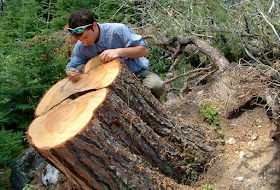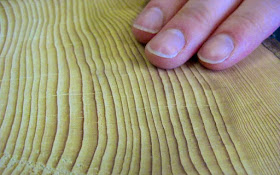 |
| Dendrochronology |
Dendrochronology is the science of examining and comparing growth rings in both living and aged woods to draw inferences about past events and environmental conditions.
In forested regions with seasonal climates, trees produce a growth ring to correspond with each growing season. At the beginning of the growing season, when conditions are optimum, the vascular cambium produces many files of large xylem cells that form wood.
As the conditions become less optimal, the size and number of cells produced decreases until growth stops at the end of the growing season. These seasonal differences in size and number of cells produced are usually visible to the unaided eye.
  |
The layers produced during rapid early growth appear relatively light-colored because the volume of the large cells is primarily intracellular space. These layers are frequently called springwood because in northern temperate regions spring is the beginning of the growing season.
Wood formed later, summerwood, is darker because the cells are smaller and more tightly compacted. The juxtaposition of dark summerwood of one year with the light springwood of the following yearmarks a distinct line between growth increments.
The width of the ring between one line and the next measures the growth increment for a single growing season. If there is a single growing season per year, as in much of the temperate world, then a tree will produce a single annual ring each year.
Tree Rings and Climate
Leonardo da Vinci is credited with counting tree rings in the early 1500’s to determine “the nature of past seasons,” but it was not until the early 1900’s that dendrochronology was established as a science.
 |
| Touching the tree rings |
Andrew Douglass, an astronomer interested in relating sunspot activity to climate patterns on earth, began to record the sequences of wide and narrow rings in the wood of Douglas firs and ponderosa pines in the American Southwest.
Originally, trees were cutdown in order to examine the ring patterns, but in the 1920’s Douglass began to use a Swedish increment borer to remove core samples from living trees.
This instrument works like a hollow drill that is screwed into a tree by hand. When the borer reaches the center of the tree it is unscrewed, and the wood core sample inside is withdrawn with the borer.
The small hole quickly fills with sap, and the tree is unharmed. Borers range in size from 20 centimeters to 100 centimeters or more in length, so with care, samples can be taken from very large, very old living trees.
Counting backward in the rings is counting backward in time. By correlating the size of a ring with the known regional climate of the year the ring was produced, a researcher can calibrate a core sample to indicate the surrounding climate during any year of the tree’s growth. By extending his work to sequoias in California, Douglass was able to map a chronology extending back three thousand years.
Tree Rings and History
 |
| Tree Rings and History |
Archaeologists quickly realized that this was a tool that could help to assign the age of prehistoric sites by determining the age of wood artefacts and construction timbers.
In this way archaeologists could calculate the age of pre-Columbian southwestern ruins, such as the cliff dwellings at Mesa Verde, Arizona, by cross-dating living trees with dead trees and the latter with timbers from the sites. In 1937 Douglass established the Laboratory of Tree-Ring Research at the University of Arizona, which continues to be a major center of dendrochronological research.
Fine-Tuning
In the mid-1950’s Edmund Schulman confirmed the great age of living bristlecone pines in the Inyo National Forest of the White Mountains of California. In 1957 he discovered the Methuselah Tree, which was more than forty-six hundred years old. The section of forest in which he worked is now known as the Ancient Bristlecone Pine Forest.
During the next thirty years, Charles Ferguson extended the bristlecone chronology of this area back 8,686 years. This sequence formed the basis for calibrating the technique of radiocarbon dating. In the 1960’s, radiocarbon analysis began to be used to determine the age of organic (carbon-based) artefacts from ancient sites.
 |
| Fine tuning |
It has the advantage of being applicable to any item made of organic material but the disadvantage of having a built-in uncertainty of 2 percent or more. Tree-ring chronologies provide an absolute date against which radiocarbon analyses of wood samples from a site can be compared.
At about the same time, Valmore La Marche, a young geologist, began to study root growth of the ancient trees to determine how they could be used to predict the erosional history of a site.
By crossreferencing growth ring asymmetry to degree of exposure and slope profiles, he was able to estimate rates of soil erosion and rock weathering, which in turn could be cross-referenced to the climatic conditions predicted by growth rings in the stem.
La Marche and his colleagues, particularly Harold Fritts, continued to “fine-tune” the reading of growth rings to be able to take into account factors such as soil characteristics, frost patterns, and daily, weekly, and monthly patterns.
The Oldest Tree
The Methuselah Tree, mentioned above, is the oldest known living tree. Schulman also cored a forty-seven-hundred-year-old living specimen in the White Mountains, but he did not name it or identify its location.
While most of the living specimens older than four thousand years are found in the White Mountains, the oldest living tree was discovered in the Wheeler Peak area of what is now Great Basin National Park in eastern Nevada.
This tree, variously known as WPN-114 and the Prometheus Tree, was estimated to be between forty-nine hundred and fifty-one hundred years old when it was cut down in 1964 as part of a research project. The controversy that followed has left many interesting but unanswered questions.